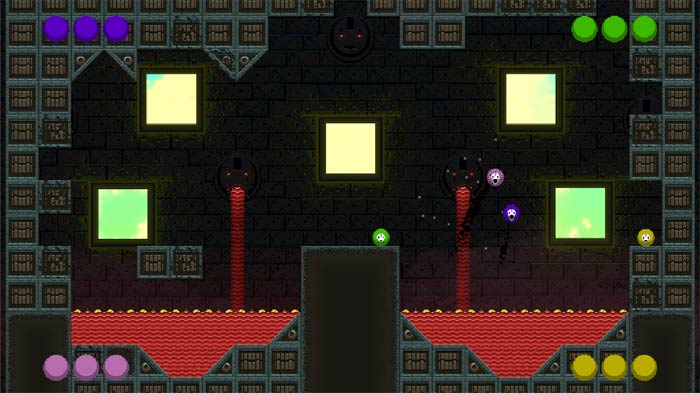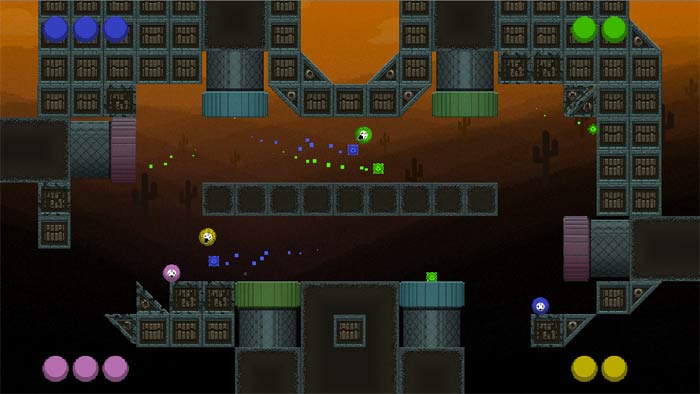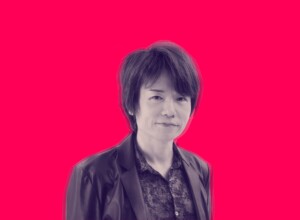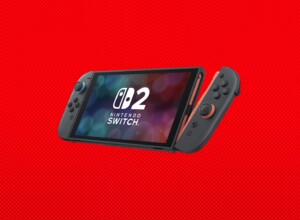How a game inspired by Super Smash Bros was cooked up in the lobby of a Premier Inn Hotel.
A few weeks before EGX Rezzed I met with upstart development studio, The Dangerous Kitchen. The location, the lobby of a Premier Inn Hotel in West London. There’s nothing unusual about that, except that this particular lobby serves not only as the location for our interview but also as the place where The Dangerous Kitchen’s first game, De Mambo, has been in development for the past six months.
In our recent feature on Crossy Road we noted that developers Hipster Whale didn’t embody that rock ’n’ roll spirit. Meeting Shaun Roopra, Amit Rai and Lucy Dove, the opposite is true. Here are three friends who had an idea, and went for it.
De Mambo is a fast-paced platform fighting game featuring competitive multiplayer and with a single player mode in development. If the game reminds you of a certain Nintendo title, that’s absolutely deliberate.
“We wanted to channel our hype for Smash Bros into something,” says Roopra. “It was very spontaneous. More like a creative exercise.”
“It kind of created itself. We had limitations and then we put limitations on ourselves. It was a just a small game, something you could play when your teacher isn’t looking. It was supposed to be played with one hand, just four keys,” explains lead developer, Rai.

This intended simplicity was partly due to fact that when development started the team were fresh out of university and couldn’t code a line between them. Roopra, Dove and Rai studied animation together, and when the time came to make a game they had to quickly skill-up. Rai was ‘sacrificed’ to coding duties whilst Roopra and Dove manage art, design and gameplay, although it’s apparent that it’s very much a collaborative effort. They settled on upon using the Unity engine, giving them a solid base upon which to try and fail with new ideas.
“Unity does half of the language for you. Once you get a grip of it, it’s really, really good,” says Rai who is learning his craft through YouTube tutorials.
David Helgason would be pleased.
Smash and Sakurai
Nintendo’s influence stretches far beyond De Mambo’s gameplay inspiration. Their design philosophy can be felt throughout and serves as unwritten guide for development.
“There are a lot of things that Nintendo do that we like to embody and take into account,” says Dove.
“We don’t try and copy Nintendo, but we try to do things the way they would do it. The way they innovate every time,” agrees Rai.
“Smash Bros is a fighting game but done differently. So we started with our own minimal version of Smash Bros and then said what can we do?”
Roopra, who guides the overall creative direction for the game, explains further, “Smash creator Sakurai talked about his game design philosophy. Looking at the fun core of an experience then rebuilding a game from its core. So we thought, let’s use his philosophy and rebuild Smash Bros. And that was the beginning.”

Naturally, Shigeru Miyamoto’s influence is also evident, particularly in terms of De Mambo’s control scheme. The game uses a D-pad and one action button but that doesn’t mean it’s a simple game. Movement, jumping and three levels of attack are all managed through these two inputs.
“Miyamoto talked about the GameCube controller and having that big button, because if it’s a good game that’s all you might need. That’s where the whole ‘one button’ thing came from,” says Roopra.
“That went hand in hand with my limitations at the time too,” Rai admits.
“It made it more realistic for me to go ‘Yeah, I can try and do this.’ Because if it was more like a question of ‘go and make Skyrim,’ I’d be like ‘You make Skyrim!’
The game is a reflection of the team’s growing capabilities, pushing them to learn and experiment more.
“I’ve had the final word a few times, because I will know what works and what can be done,” continues Rai.
“Some of the things these guys come up with, (things like) ’maybe we could have a giant babooshka with artificial intelligence that flies around…’ but I like the challenge. I could say this is hard, but at the same time it’s really, really fun, it’s the best thing we’ve done. I don’t want to do anything else.”
“I don’t think we are going to add too much more,” says Roopra. “A lot of people said we need power-ups in the game. But I don’t personally think we need them.”
“Shaun will want to do things in a certain way and I will argue as player’s will expect certain things in a game, but I always end up agreeing with Shaun,” explains Rai.
“For instance, timers. Timers came from arcade machines and people are putting that in modern console games. We are just removing fluff in a way. But we need to meet in the middle so that players understand it.
Sneezy cheese and the Simpsons
Humour is also evident in De Mambo. As you blast your opponents around the screen in a chaotic blaze of colour it can take a second to notice that the bouncy block is actually a little fat belly. And yes, that block there, is a block of cheese that sneezes.
“I used to play Sega MegaDrive, and in the games I played there was always one level I used to hate because it had guts or something like that. You’d be playing in some castle and then the next thing you know you are in a room full of intestines,” recalls Rai.
“The first thing Shaun did was say we’ve got to make a pipe that’s like a gut!” says Dove.
“One of us will draw something, we’ll discuss its functions, then translate it into pixels, then I will add polish. For example, Shaun came up with the belly then I did the asset.”
“We needed a block that bounced you, so I thought – a belly! It just made sense,” says Roopra.
Roopra wears his influences on his sleeve, a mixture of the bizarre and the smart, the artistic and the lunatic.
“I learned everything from The Simpsons. I would study something at school, go home, watch an episode and see what I studied that day. It was crazy. It just synchronises,” he says.
“Frank Zappa is also someone I really love. The ‘absurdity is the only reality’ concept is an inspiration. His music is technically amazing but it’s also stupid at the same time, which I love. He doesn’t take himself seriously.”
Rezzed and Residence
A few weeks after we met De Mambo was on show at EGX Rezzed in London. Hooked up with four SNES controllers the game proved popular and was well received.
“We had, really, no idea. We hoped for the best, and everything went well, I mean I knew our game wasn’t utterly terrible, but it was unexpected,” says Dove.
“EGX was the most tiring experience of my life, I felt like I was close to death… but I wouldn’t change that for the world,” says Roopra.
The Rezzed build also introduced a new gameplay mechanic. Conscious that players might get bored waiting for a match to finish if they died they can now interact with the screen and grab a chance to re-enter. It’s a typically Nintendo touch that looks after the player, even when they lose. Naturally, it’s called loser-mode. That such a key feature went from idea to implementation in just two weeks bodes well for De Mambo, and for The Dangerous Kitchen’s prospects as a studio.

The time has also come to leave the Premier Inn, at least for a while. The team have been fortunate enough to have been awarded a space at the new Playhubs facility in central London. It’s a daunting prospect for the young studio.
“The corridors scare me since they remind me of ‘The Shining’,” says Roopra of Playhubs’ Somerset House location.
“It was a bit nerve-wracking since we’re not used to a professional environment and the opportunities there are so beyond what we expected,” says Dove.
With De Mambo well into development, their first expo under their belt and new supportive environment in which to work The Dangerous Kitchen have come a long way in a short time. They obviously have talent but most impressive is their commitment to making a the game they want to make whatever the obstacles.
“The only way you can fail is by changing directions,” says Rai. “If you keep trying, you’ve not failed.”
–






